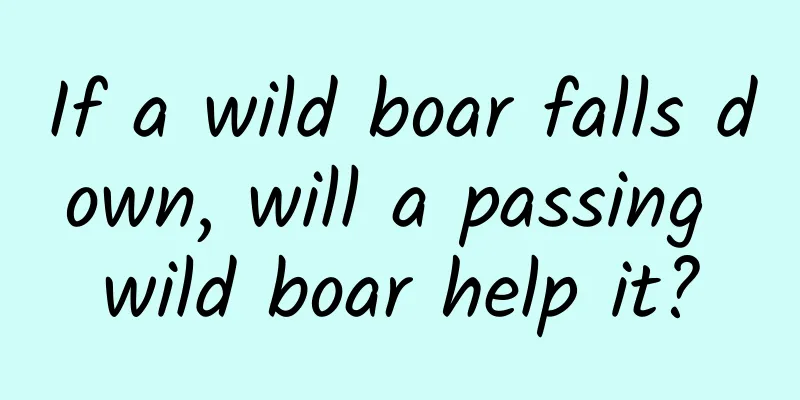If a wild boar falls down, will a passing wild boar help it?

|
You will not only encounter wild boars in mountains, wheat fields, and grasslands, but you will also inevitably run into them unexpectedly in busy cities. Imagine this: Maybe you are a citizen walking in the CBD of Hexi District, Nanjing, and “Brother No. 2” suddenly breaks into your life. Maybe you are a diligent milk tea shop clerk, and suddenly you hear the Spanish Pig Fighting Song, and you start fighting with the pig; Maybe you were walking alone on campus after your advanced math class, and a pair of wild boars suddenly appeared, rubbing their ears together. That sweet scene shocked your heart: pigs have partners, but I... It is not shameful to be crushed by a thick-skinned wild boar. After all, most people have no choice but to run away when they encounter a wild boar. But wild boars are highly intelligent animals. In many research projects, they can quickly complete learning and memory tasks. They can not only easily see through traps set by humans, but also have the awareness of group cooperation. An animal scholar described the difficulty of hunting wild boars in this way: "Wild boars are very smart. If they don't hit the target in one shot, they will become alert and must change to another hunting method to catch them again." In some cases, facing hunters with guns, wild boars can even learn how to escape the shooting area in a short confrontation. What’s even more amazing is that once a wild boar is caught in a trap, other wild boars passing by may come to the rescue and rescue their accomplices. Pigs Develop Empathy? It sounds a bit outrageous, but what kind of scene would it be like to see a wild boar saving another wild boar? According to a research report published in Scientific Reports, the rescue operation between wild boars was clean and efficient, the techniques were professional, and they even took time out of their busy schedule to conduct a teaching activity for other onlookers [1]. The researchers set up a camera in front of a simple wild boar trap. At 11:21 p.m., two young wild boars that were inexperienced in the world were attracted by corn cobs. When they were eating, the mechanism was triggered and they were locked in the trap. Image source Observation of rescue behavior in wild boar A wooden stick that can only be moved from the outside is stuck behind the trap door. The wild boar can be released after the stick is moved. An hour later, the roaring wild boar in the cage finally attracted a group of its kind, including an adult sow and seven piglets. Considering the age of the trapped piglets, the researchers also speculated that the sow might be their mother. Hearing the painful screams of the trapped piglets, the adult sow began to skillfully fiddle with the wooden stick on the front door. Image source Observation of rescue behavior in wild boar After 10 minutes, the wooden stick at the front door was completely removed and the front door was slightly open. Then the adult sow started to repeat the same trick on the wooden stick at the back door. Image source Observation of rescue behavior in wild boar In the end, the two wild boars in the trap were all rescued, and the seven little pigs passing by also watched the entire rescue process of "seeing injustice and helping with sticks" on the spot. Image source Observation of rescue behavior in wild boar During the 29-minute rescue, the "repeat offender" acted quickly. At the same time, the adult female pig was obviously aware of the danger of the action. It kept its hair erect, showing an intimidating and threatening fighting posture. But the surprise of this adventurous rescue is not only the wild boar's super intelligence, but also its "selfless" performance. Self-rescue is often just a matter of instinct and intelligence, but rescuing others requires more complicated reasons. Not all “mutual aid behaviors” can be called “rescues” between animals. In theory, for rescue behaviors between animals to be recognized by scientists, they must meet four conditions [2]: The trapped person must be in a state of distress and threat, such as injury or death; Rescue attempts involve great danger to the rescuers; There is active intention in the helper’s behavior; Rescuers do not receive any substantial direct rewards such as food or mating in the rescue. In other words, the rescue process requires a certain amount of sacrifice and risk-taking. For this reason, rescue behavior is also considered an extreme form of "prosocial behavior" (a behavior that is in line with social expectations and has no obvious benefits to the actor itself, but the actor consciously and voluntarily brings benefits to the recipient of the behavior). This phenomenon has only occurred in a small number of animal groups, including primates, ants, mice, humpback whales, dogs, etc. [1]. Rescue operations have only occurred in a small number of animals. Data compiled from literature [1] Why does rescue behavior only exist in a small number of animals? Could it be that actions like "pigs saving pigs" are driven by a higher life instinct? Sympathy? Or just a momentary "want"? Theoretically, an individual's survival instinct should be to maintain the continuation of its own genes. Rescue also means the risk of death. There must be more complex reasons that drive animals to make decisions that go against their will to survive. Scientists have given two different guesses about the reasons behind this: Don’t think too much, the “rescue” of animals is just a momentary urge It seems that humans are more willing to attach good moral intentions to the humane behavior of animals, such as lambs kneeling to suckle and crows repaying their parents. However, scientists always like to make explanations to shatter the filter: lambs kneel to suckle because lambs cannot get milk when standing, and crows repay their parents because the ancients had poor eyesight and mistook the gray-haired young birds for old birds. As for why the animals took rescue action, some "straight male researchers" speculated that they might just be tempted and curious about the trap. Researchers recorded scenes where some mice, after fiddling with the trap and rescuing their companions, actually went back into the trap themselves, seemingly completely unaware of the dangers of the trap. Perhaps, rather than rescuing out of sympathy, the mice were just trying to get in for fun and happened to rescue their companions [3]. Animal rescue out of compassion But more research results and experimental observations suggest that behind animal rescues may be sympathetic behavior inspired by the perception of the painful emotions of their companions. In the experiment mentioned above, the mice rescued their companions but then fell into the trap again. It is very likely that the mice did not sense the danger. Once they realize that their companions are in danger, these animals will anxiously take rescue actions. Studies have shown that when rats are faced with two of their own kind trapped in a trap, they will prioritize rescuing the one in danger, such as the one struggling in water and showing pain.[4] Scientists have analyzed that it is precisely because rats are able to recognize the danger and pain of their own kind that they take action to rescue it first, which is also a manifestation of empathy and compassion in animals. Faced with these two completely different explanations, I couldn't help but wonder: When the owner faints, falls, or is in danger, will the pet try to rescue? I tried to faint, but the cat didn't respond. I couldn't help but feel overwhelmed by the indifference of the cat I raised. Combined with the previous scientific research results, the second time I tried twitching for a while, trying to show the cat pain and observe whether it would take action. Although the cat showed obvious concern for my convulsions - walking around, observing and sniffing - this only shows that when I was in obvious danger, the cat might have noticed something was wrong, but it did not have the ability to rescue me (which is far worse than the wild boar). Although there is still no consensus on the reasons why animals rescue each other, I still want to believe that animals, like humans, have the love and courage to help others when facing danger. As for you, which conjecture would you prefer to believe? References [1] https://www.ncbi.nlm.nih.gov/pmc/articles/PMC8355341/#CR15 [2] https://pubmed.ncbi.nlm.nih.gov/20585494/ [3] https://www.ncbi.nlm.nih.gov/pmc/articles/PMC6677799/ [4] https://pubmed.ncbi.nlm.nih.gov/25964095/ Author: Zhao Yuanling Editor: biu Cloud also helped edit this article Guokr (ID: Guokr42) If you need to reprint, please contact [email protected] Welcome to forward to your circle of friends |
<<: How big is the pond? Scientists give the first accurate number
Recommend
Science illustration | How to protect "underwater grasslands" that bloom and bear fruit in seawater?
...
What kind of rubber band is this that can achieve great results with just a little effort?
Produced by: Science Popularization China Author:...
Tencent Advertising Strategy for Weight Loss Industry
This article focuses on six sections: "Link ...
Do you believe that Android users can use Apple Maps?
Since its launch, Apple Maps has been criticized ...
There are so many promotion channels, how can we combine them to maximize traffic!
Currently, the total number of mobile app users h...
100 fissions summarize these 3 user growth rules!
With the "Announcement on the Handling of In...
Facebook promotion plan and traffic diversion skills
Doing these things well can help you get potentia...
What are the commonly used SEM statistical tools? What are the commonly used statistical analysis tools for SEM?
There are many website statistics tools, such as ...
Li Chen's personal profile: How to determine whether a website has been punished by Baidu?
If the website traffic drops sharply during opera...
Python Quantitative Finance Practice by Wall Street Masters
Introduction to Wall Street Master-level Python Q...
How much does it cost per month to rent a computer room with 1TB bandwidth server?
How much does it cost to rent a computer room wit...
Can it bear "a huge weight"? Sisal wire rope core: the "behind-the-scenes hero" of elevator safety
1. What is sisal? Sisal is a perennial tropical h...
Popular Science on Flood Control丨How to distinguish between “red, orange, yellow and green”? Understand the rainstorm warning signals in one picture
Popular Science on Flood Control丨How to distingui...
China’s top priority: energy structure adjustment and carbon emission reduction
In August , at least 10 provinces in China cut po...









